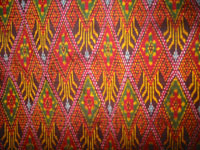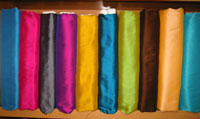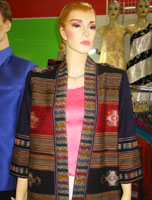Thai Silk
Before I head back to the United States for a visit, I make some enquiries as to what people may like to have as a gift from Thailand. Very often the answer is ‘silk.’ Even I, the ‘jeans and a t-shirt’ person, have recognised the intense beauty and relatively low cost of silk in Thailand. The patterns can be so intricate and striking at times that silk goes beyond its practical functionalities and enters the realm of art. In fact, I don’t just sometimes wear silk. I also hang it on the walls.
The origin of silk production and weaving is ancient and controversial but suffice it to say that most scholars agree it originated in China around 3 BC and traces of silk production have been found in Thailand that date back to 4 BC. What makes Thai silk one of the more prestigious of silk varieties is the wave-like quality of the silk threads used in weaving and the ancient and skilled craftsmanship of Thailand when it comes to making these threads into elegant and beautiful patterns. Although I am adept at admiring silk, I had no idea how it was produced (except the fact that a silkworm was involved) before I had the opportunity to watch it being made. Here is a short version of silk production.
Although I am adept at admiring silk, I had no idea how it was produced (except the fact that a silkworm was involved) before I had the opportunity to watch it being made. Here is a short version of silk production.
It takes three to four weeks for an egg to develop into a silkworm. The silk worms are then placed in large bamboo trays and fed mulberry leaves during their 30-day growth period which allows them to increase their weight 10,000 fold. They are then placed in circular bamboo trays where they spin their cocoons at the rate of twelve centimetres per minute. The entire process takes about 36 hours. They later hatch about ten days after having completed their cocoon. After the cocoons are completed, man intervenes and takes the soft material that they have wrapped themselves in to produce silk. If the pupae emerge, they will ruin the cocoon. If this happens, they are quite likely to be consumed by the workers for lunch with the damaged cocoons being used for lower grade silk production.
grade silk production.
The cocoons, with pupae still encased, are then placed in simmering water to separate the threads. This is a somewhat controversial but necessary task. As Buddhists prefer not to kill living animals, there are some that would refuse this assignment.
Silk strands are pulled out of the water using bamboo poles and are then twisted together to form a large thread which is then reeled onto a spool. The silk from Thailand’s caterpillars varies from light gold to light green in colour and one cocoon contains a single strand ranging from 500-1,500 meters long.
Next the silk is inspected and graded. Silk from the outer layers of the cocoon are more coarse and therefore used for furnishings while the threads from the inner layers are of a higher grades and are used for weaving cloth.
After this the silk is soaked in water to remove its gum-like coating before it is dyed. It is then plied together to make threads and wound onto spools or drums in preparation for weaving.
spools or drums in preparation for weaving.
Two types of silk are used in this process, one for the background colour and one for the patterns in the foreground. Weaving requires patience and skill. Patterns can range from the very plain and subtle to the bright and intricate. Silk is made into anything from umbrellas to ties to pocketbooks and can be found at most any market or street corner.
Traditionally, farmers produced silk when they were not working in the fields and it was a skill passed on from generation to generation. The styles and colours used in weaving typically reflect the region that the silk was produced in. Due to modernization, industrial machinery has been employed in silk production but many traditional methods are also still used with the handmade products being more prized and expensive at the end. Most silk comes from Northern and Northeastern Thailand as good growing grounds for mulberry (silkworm food) can be found there.
Thai traditional dress reflects Thailand’s long history and capabilities with silk. Silk is worn on both formal and informal occasions and Her Majesty the Queen, besides being an advocate for and strong supporter of the silk industry as illustrated by the several hand-weaving projects she has launched, wears it with pride.
Jim Thompson is a man who is almost as famous as Thai silk itself. He was an American silk entrepreneur who disappeared under strange circumstances in Malaysia in 1967. He made his fortune helping revive the Thai silk industry after World War II. His house (constructed in stunning traditional Thai style) is open to the public and hosts his collection of art and antiques from the Southeast Asian region. His is one of the finest brands of silk even today. A visit to the Jim Thompson house, located on Rama I Road in Bangkok, is one activity I always recommend to anyone visiting Bangkok.
